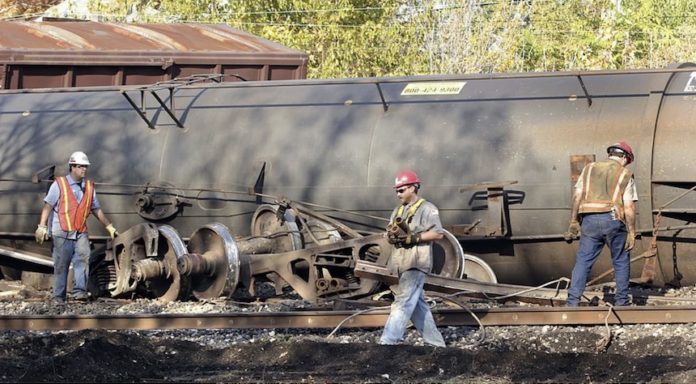A train containing hazardous materials went off the rails Thursday in Van Buren Township outside Detroit, Michigan, just two weeks after the ruinous derailment in East Palestine, Ohio.
Recent incidents have raised concerns about the growing number of train accidents in the United States.
The Federal Railroad Administration and Department of Transportation officials have not commented on whether the derailments were coordinated. There are other factors, including safety and efficiency priorities at work that could explain why Norfolk Southern’s derailment in East Palestine was prevented. This could lead to more serious consequences.
This is a list of derailments that occurred in the past year:
- Feb. 16 — Van Buren Township, Michigan: A train operated by Norfolk Southern had around six cars go off the tracks, at least one of which was carrying hazardous materials.
- Feb. 13 — Splendora, Texas: A Union Pacific train had 21 cars go off the tracks after a collision with a tractor-trailer. Newsweek indicated that the tractor-trailer leaked diesel and oil.
- Feb. 13 — Enoree, South Carolina: A CSX train had three cars come off the tracks. The scene was reportedly cleared in short order.
- Feb. 3 — East Palestine, Ohio: A train operated by Norfolk Southern carrying around 150 loaded cars, nine empty cars, and three locomotives had around 50 cars go off the tracks, several with toxic contents, including vinyl chloride, hydrogen chloride, ethylene glycol, monobutyl ether, Ethylhexyl acrylate, isobutylene, and phosgene.
- Feb. 1 — Detroit, Michigan: A CN Rail train had eight empty railcars derail and one teeters over the side of a rail bridge.
- Jan. 21 — Outside Loris, South Carolina: Six gravel-laden cars on an RJ Corman Railroad line went off the tracks a mile south of Allsbrook.
- Jan. 19 — Trinway, Ohio: An Ohio Central Railroad train composed of 97 cars went off the rails. No leaks occurred, reported the Times Recorder.
- Jan. 9 — Lake City, South Carolina: A CSX freight train struck an empty car that had been left on the tracks; 25 cars went off the tracks.
According to the U.S. Department of Transportation Federal Railroad Administration, there were 471 derailments in the U.S. in 2022. The five states with the most derailments were Texas (44), Georgia (37), Ohio (33), Tennessee (29), and Illinois (29).
The derailments resulted in $92,958,685 in reportable damages and four injuries claims.
Although incidents involving hazardous substances are costly, they don’t always have to be covered in dollars or cents. This is what East Palestine has learned.
Grid reported that railroad accidents involving hazardous substances inflicted around $17 million in damage in 2022. Reports indicate that rail hazmat accidents inflicted around $15 million in damage in 2021.
Federal data indicates that Norfolk Southern, which has recently experienced a “double-digit percentage rise in revenue and… record revenues operational income”, was responsible for more than half the hazmat losses in rail transport in 2022.
Norfolk Southern’s train was involved in an accident that took place in Albers, Illinois on September 19, 2022. It exploded and emitted more than 20,000 gallons of methyl methacrylate monomer (a liquid ). The incident report estimated that $3.2 million was the total damage.
Another example: A Norfolk Southern train spilled approximately 20,000 gallons of paraffin wax in Sandusky, Ohio on Oct. 8, 2022. According to reports, this caused damage of $2.6 million.
The U.S. Government Accountability Office published a report in 2019 that dealt with recent derailments. According to seven Class I freight railroads: “Freight train lengths increased in recent years,” U.S. Government Accountability Office reported… Officials cited improved efficiency and economic benefits as reasons for longer freight trains.
According to the report, railroad workers’ unions and the FRA have said that it can be more challenging for longer mixed-freight trains than unit trains in certain circumstances. This can be due to differences in the length and weight of the cars, as well as additional DP locomotives.
Bob Comer, an expert railroader, told Grid that he had examined many accidents and that he believed that Grid was talking about an American industry that began in 1825 and put safety and money first. They’ve also increased the length of trains and reduced maintenance staff.
Comer stated that longer trains mean more cargo and potential damage on a larger scale.
Jared Cassity works as a legislative director for SMART Transportation Division. Politico was told by Cassity that the longer trains run, the heavier they are and the more wear on the equipment and rails.
Cassity states that wear and tear can cause “more unintended train separates,” which eventually leads to the train breaking apart.
Longer trains don’t always require more staff.
Republican Sens. J.D. Vance (Ohio) and Marco Rubio (Fla.) penned a letter Wednesday to DOT Secretary Pete Buttigieg, drawing attention to the fact that the Norfolk Southern train that darkened the sky over East Palestine and sullied the waters “had a three-member crew overseeing the entirety of its 150 cars: a locomotive engineer, a conductor, and a conductor trainee.”
“Precision-scheduled Railroading is a way railroad companies such as Norfolk Southern can improve efficiency and lower costs by moving more freight using fewer employees. According to former and current rail workers, as well as industry observers, reform advocates, and reform advocates, this could have been a contributing factor in the accident.
The DOT Office of Inspector General published a February 2016 report that accounted for another reason why rail hazmat incidents seem unabated.
According to the report, FRA had not conducted a thorough evaluation on hazardous material transport risks that adequately addressed national-level risk. These models, for instance, only assess the amount and proximity of hazardous materials that are being routed through particular regions.
While inspectors receive good training and guidance the report states that complicated information systems and outdated portals hamper the enforcement of hazardous material regulations.
FRA also pursues civil penalties in cases involving violations of hazardous material regulations, according to the report. However, several DOT Orders indicate that FRA does NOT refer criminal cases to our office.
In the absence of holding offenders accountable for non-compliance when there are “serious cases of non-compliance”, it seems that this has served to lower penalties and disincentives.
FreightWaves reported this week that Ken Hoexter (an analyst at Bank of America) suggested that railroads may have to pay between $40 and $50 million in “casualty fees” for the Ohio disaster of February 3.
Jason Seidl works as an analyst for Cowen Financial Services. He said Tuesday that while the impact and severity of the train derailment in early March are still unknown, history shows that it could not have a significant long-term effect on rail carrier share. ”
According to the New Republic, Railroad Workers Union believes all of the above factors may have contributed to the types of accidents that took place in East Palestine.
While the RWU stated that the wreck was caused by a mechanical problem in one of the cars’ axles, the RWU suggested that the long-term cause may have been the “cult of Operating Ratio” of NS, Class 1 railroads, which prioritized reducing costs and staffing.
“The devastation of Train 32N took years to come about. However, the RWU said that other train accidents like 32N could still happen. ”
According to the Independent, Ian Jefferies of the Association of American Railroads has stated that 99.9% of hazardous materials cargo are safely transported despite the Ohio catastrophe.
Jefferies noted that large quantities of dead fish were being washed down Ohio streams, and East Palestine residents considered the possibility of cancer-laden futures. Jefferies noted that railroads were the most secure way to move goods across the country. ”
We reached out to the Federal Railroad Administration as well as the Department of Transportation in an effort to learn if they are concerned about derailments occurring more often and what steps they have taken to avoid them. We also wanted to know if any recent derailments were coordinated.










